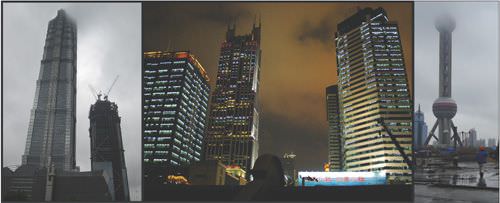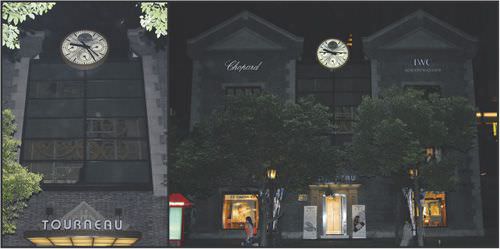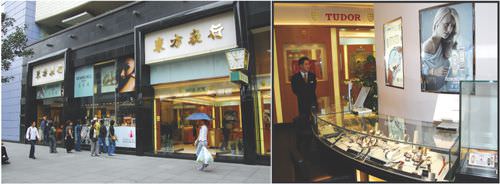If Shanghai were a country, the city alone would be among the 40 largest economies in the world. With a Gross Domestic Product of US$114 billion in 2005, it surpassed that of the Philippines and the Czech Republic. Its trade with the rest of the world amounted to US$350 billion. That same year, direct foreign investment reached US$60 billion. More than 40,000 foreign companies have already opened offices there, and 300 new foreign-capital companies are created each month.

Jin Mao tower, Pudong skyline and TV tower
Shanghai’s 18 million inhabitants live in some 4000 buildings (more than New York City), while some 19,000 new construction sites will provide 1000 additional high-rises by 2010. This does not even count the creation of a series of satellite cities with European themes, including a German-style design inspired by Weimar for the city of Anting, and Victorian houses and pubs created for the new Thames Town neighbourhood of Sonjiang. The port of Shanghai, with 443 million tons of merchandise handled in 2005, is by far the largest port in the world. And this dizzying ascension is not about to end here. The GDP of Shanghai annually flirts with increases of 11 percent to 12 percent.
While all these numbers may seem abstract, visitors to Shanghai can get a physical understanding of their magnitude when leaving the ultra modern Pudong International Airport and travelling the 7 minutes (at speeds of up to 431 kilometres an hour on the modern German built Magnetic Levitation railway) that it takes to reach the Pudong district. This new area faces the well-known Bund, across the river, with its row of colonial banks constructed during the times of the famous Concessions. Once in Pudong, visitors take a lift to reach the reception of the highest hotel in the world, the Hyatt Shanghai, situated on the 54th floor of the Jin Mao tower. From their rooms, they can get an idea of the extent of the city, and the extent of the damage, because it goes without saying that such a rapid acceleration in growth does not happen without collateral damage, in both human and environmental terms.
The rush of the global brands
This formidable economic thrust has obviously aroused the interest of the large global brands from around the world. A veritable furore has engulfed retail business in the city, whose inhabitants have seen their purchasing power increase 10.9 percent during the first few months of 2006, and where new millionaires are born every day. A new gold rush is happening and, as a knowledgeable city observer tells us, “A day doesn’t go by that I don’t receive an invitation for the inauguration or opening of a new store.”
A genuine flood of brands in the luxury, accessories, and fashion categories, among others, race to obtain the best locations, where prices are increasing rapidly. “Those who are not yet there are ready to pay very high sums to acquire their pied-à-terre in China,” explains Michael Hart, Head of Research for the firm, Jones Lang Lasalle.
Today, there are no less than 16,000 franchised boutiques, 15 immense shopping malls (covering over a million square metres), and another 25 shopping centres under construction or in the developmental phase. By the end of 2006, Shanghai will have 150 hypermarkets.
It has been announced that, in the next few weeks or months, a number of major openings will be held, among them are H&M, Gap, Versace, the ice cream maker Häagen-Dazs, the electronics giant Best Buy, which will inaugurate an 8,400 square metre store, a 1,600 square metre second store for Zara, a Baccarat boutique designed by Philippe Starck, and the tenth store for Carrefour. We should also mention that Saks Fifth Avenue has purchased an entire street in the Art Déco neighbourhood behind the Bund.
Watchmaking activities
In this more than frantic landscape, luxury brands are enjoying very special appeal. The Chinese consumption of luxury products of all types, represents a good 12 percent of global purchases. In the sector that interests us the most, watches, major moves are in full swing, and the struggle for the best locations is very tense. This battle for the most strategic positioning seems particularly fierce between the two giants, the Swatch Group and Rolex. It resembles a little the competition, in certain corners of the planet, between Coca Cola and Pepsi Cola. It is impossible to see one cola brand name without immediately running into the other one only a few feet away. In the watch sector, this rivalry is centred primarily between Omega and Rolex, with the focal point being two major upcoming events: the Olympic Games in Beijing in 2008 (for which Omega is a sponsor), and the Universal Exposition to be held in Shanghai in 2010.
“In China, reputation is inseparable from the question of size. The more one seems grand, the more one is respected,” explains a gentleman quite familiar with the issue, Jean-Pascal Salvaj, Chief Representative of the Watch Division of the Richemont group in Shanghai, where he has lived for the last five years. The importance given to size explains the current wave of very large watch store openings or planned openings. Cartier will soon inaugurate a 600 square metre boutique in Beijing, while Rolex will open a flagship store covering 500 square metres, the largest Rolex boutique in the world, which also includes Tudor, a very powerful brand in China.
And, in the race for size, the Swatch Group is getting ready to strike hard. The Swiss group is currently negotiating with the Chinese authorities to set up shop in a place that is magic, prestigious, and essential (but for the moment, we can say no more). It intends to establish more than a ‘simple’ flagship store in this new location, preferring rather a group of stores, including a centre for exhibitions and cultural activities, a bar or even a restaurant, based partially on the concept, but on a Shanghai sized scale, of its recent Cité du Temps exhibition in Geneva.
A laboratory of luxury retail
This qualitative evolution of the retail concept is visible also in other places in Shanghai, which acts as a sort of advanced laboratory in this domain. Since the market is still so new, all the brands are trying to position themselves in the best and most prestigious locations possible. An example is the recent opening in Shanghai of Tourneau, which we can unquestionably classify as the most attractive multi-brand watch store in the world (at least to my knowledge). Completed in June 2006, this store is the most visible outcome of the joint venture signed recently between Tourneau and the Hong Kong group, Peace Mark. (Incidentally, Tourneau was acquired at the end of August 2006 by a group of investors headed by Green Equity Investors, for US$300 million.)
The Tourneau store is in a small, perfectly restored, hundred-year old brick building, and a haven of peace among the skyscrapers that surround it. On the ground or first floor, we find a series of superb boutiques, dedicated to individual brands, each with around 30 square metres of space, in an open environment, decorated in accordance with the brand’s criteria. Located here are Omega, Breguet, Chopard, IWC, and Breitling. On the first floor, we find a number of slightly smaller corners that are impeccably decorated, and that house Raymond Weil (also see the following article on Raymond Weil in China and Shanghai), Glasshütte, Milus (which belongs to the Peace Mark group), Gucci, Baume & Mercier, Corum, and Ulysse Nardin, among others. An immaculate area is reserved for after-sales service, where watch repairers have access to all the necessary equipment.
But, it is on the second floor, where we discover the originality of the store’s concept and design. This area is reserved for members of the Solomon Club (the name comes from the former owner of the place). Here, members can visit a splendid library, where, placed between several display cabinets of antique watches, are dozens of works on the art of timekeeping as well as many watch trade magazines that can be consulted while the members relax in their plush armchairs. They can also enjoy a drink at the neighbouring bar or smoke a cigar on the small adjac-ent terrace covered in teak wood. Also on this floor is a private salon for major watch sales, a small museum of historical tools related to watchmaking, and quite interestingly, a wine cellar! Members of the Solomon Club can thus not only savour a great wine while talking about their latest tourbillon, but they can also seek the advice of a sommelier about purchasing a good wine. An unusual but ingenious service at Tourneau, especially in a country where apartment buildings (like the skyscrapers in Shanghai) do not have cellars, allows club members to store their wines in Tourneau’s cellar. Quite clearly, this goes above and beyond anything offered by traditional watch retail stores.
As an illustration of the ‘battle’ that we mentioned earlier between the principal watch players in China, Rolex had earlier refused to be sold in the new Tourneau store. It quickly made up for lost time, however, and opened, right next door and in association with Tourneau-Peace Mark, its largest brand name store to date. A vast space, at the foot of the adjac-ent tower, contains nearly all the models of Rolex and Tudor. Inaugurated September 5 of this year, it is still too soon to evaluate the results, but one of the Chinese salesladies told me that she is selling one to two watches per day.
This particular Tourneau showroom deserves an AAA rating, and is one of the two initial stores to be opened in Shanghai by Tourneau-Peace Mark. The other boutique is also very luxurious, but it is less cosy and inviting, having been established in the impressive, but still a bit empty, shopping mall located next to the Hyatt Hotel in the famous Jin Mao tower. The stated ambition of Tourneau-Peace Mark is to open about 30 luxury stores around China in the next five years.

Tourneau Shanghai store
New networks of selective distribution
While the Tourneau illustration is the most striking example of the quality of distribution networks that are being set up in China today, it is not, by far, the only one. Many other players and brands are moving in this direction primarily because the traditional distribution channels are of such poor quality.
One of the central figures in the current renewal is the large group, Xinyu Hengdeli, the largest distributor of high-end Swiss watches in the People’s Republic of China. A public company quoted on the Hong Kong stock exchange since September 26, 2005, its principal shareholder is the Swatch Group (Hong Kong), which purchased a 6 percent stake in the company in January 2006. Xinyu Hengdeli is at the head of a vast distribution network made up of 73 boutiques in the largest cities in China. The group has established solid relationships with the largest international brands, including the Swatch Group, Richemont, LVMH (which recently announced that it had also purchased shares in the Group through the Hong Kong stock exchange, and also its intention to increase its holdings), Rolex, and Desco (a distributor of many brands in Asia, and owner of Maurice Lacroix). Xinyu Hengdeli is the agent for 19 watch brands, including the exclusive rights for 15 brands from these four large international watch groups. It also has its own brands, Nivada, Olma and Numa Jeannin.
In a visit to one of Xinyu Hengdeli’s main stores in Shanghai, on Huaihai Road, we discover an immense multi-brand space, perfectly appointed, and composed of both corners and traditional window displays. On this particular day, the eve of the Shanghai Festival, a large crowd comes to look. The list of products on the shelves is quite long, and would make more than one European store look pale in comparison. Among the bestsellers, according to one of the store’s managers who answered our questions with patience and kindness without knowing who we were, is the top trio of Rolex, Omega and Audemars Piguet, followed (not in any special order) by Cartier, Vacheron Constantin, Longines, Rado, Tissot, and Zenith. After these brands (again in no particular order) come TAG Heuer, Jaeger-LeCoultre (a small remark in passing: it seems that, in China, it is more difficult to sell watches in different shapes than a round watch, which explains why the proportion of Reverso versus Master timepieces is the opposite of what is sold in other countries), Raymond Weil, Maurice Lacroix, Baume & Mercier, Bucherer, Dunhill, Movado, Mido, and Edox, etc.
Other excellent networks are run by the Harmony group, which manages about 50 selective sales points throughout China, and the Oriental group, which is based in Hong Kong and is at the head of some 15 stores on the Chinese mainland. The Oriental boutique that we visited in Shanghai, on Nagjing Xi Road, is, in the words of its manager, “the most beautiful boutique in the group.” Oriental distributes 36 Swiss brands in its stores, including, in no particular order, Rolex and Tudor, Girard-Perregaux, Breguet, IWC, Chopard, Ebel, Raymond Weil, Movado, Longines, Hermès, and Louis Erard, among others. A definite sign of the gradual success of its strategy to move upmarket, Seiko is also present, but uniquely with its Spring Drive line.
Here too, the store is decorated with taste and class, composed of small, well-kept corners. Asked about its clientele, Larry Leueng, the General Manager of Oriental Watch China, explains that the perception of the mechanical timepiece is growing, and today it represents close to 80 percent of sales. So, who are the store’s customers? The majority are people over 40 years old. The youngest, with the lowest purchasing power, turn towards Tissot, Longines, a small number of Omega models, and Tudor. And, which brands are on a roll? Without hesitation, he cites, Rolex, Vacheron Constantin, Piaget, and Audemars Piguet, which seems to have effectively made important inroads into the Chinese market.

Oriental shop
Excellence of the Swiss image
The advertising investments made by the various brands are impossible to determine, but the presence of Swiss watches, in an overall manner, is quite remarkable. When strolling through Shanghai, it is hard not to see the immense billboards and the many signs, which everywhere praise Swiss watchmaking. The image of Switzerland is excellent, as was demonstrated recently by a poll conducted by Présence Suisse. This study places the country ahead of all other nations, and before, in descending order, France, Germany, Great Britain, South Korea, Austria, and the United States. Swiss watchmaking, in particular, won nearly all the votes (9.5 out of 10 people have an extremely favourable opinion of Swiss timepieces), with 50 percent of the people questioned considering watches as the main asset of the country, ahead of the attraction of the Swiss countryside (20.5 percent) and the banks (15.7 percent). The only negative factor revealed by the poll was that the competitiveness and innovative strength of the small nation were not considered to be a part of its assets. But, perhaps Swiss watchmaking can correct this image as it continues its investments in China. We certainly get this impression when, for example, we return by car to the airport. We pass a huge white fence on which at least 50 luminous signs are dotted, one after the other, that repeat Tissot, Tissot, Tissot, Tissot... On the scale, or excess, of the country.
Market Focus Shanghai: Raymond Weil: a strategic repositioning
Source: Europa Star October-November 2006 Magazine Issue








